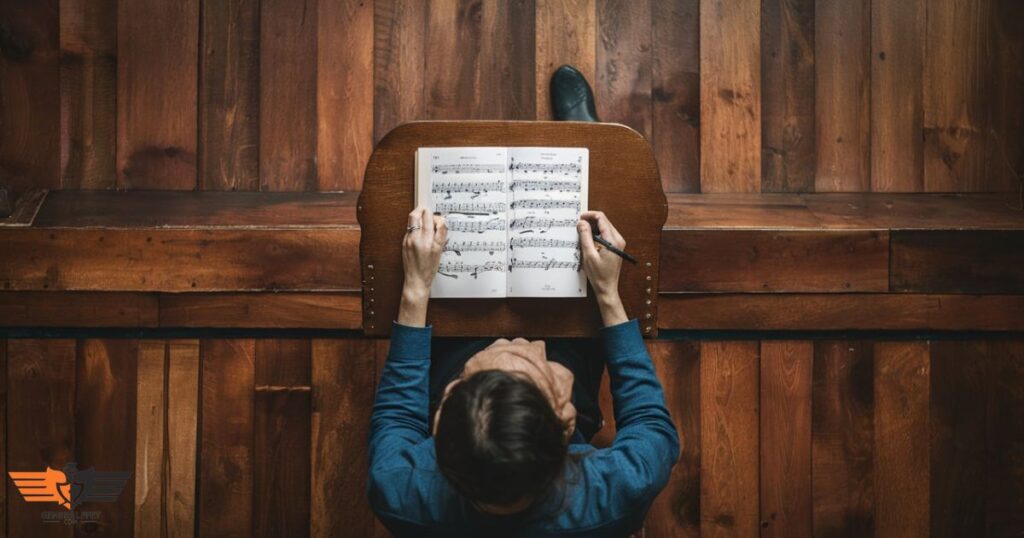The black rectangle on sheet music is a symbol representing a musical rest. It indicates a pause in the music. Musicians recognize it as a crucial part of musical notation.
Ever wondered what that mysterious black rectangle means in your sheet music? It’s more than just a symbol; it’s essential to the rhythm of a piece. Understanding it can improve your musical skills.
Demystifying the black rectangle on sheet music helps musicians grasp the importance of rests. This guide explains how these symbols shape the flow of music. It’s key to mastering timing and expression in any performance.
Introduction
When you’re flipping through sheet music, you might spot a lonely black rectangle sitting on the staff. It might look like a typo, but it’s actually a powerful tool in music called a rest.
In this post, we’re going to explore what rests are all about, why they’re shaped the way they are, and how they help create beautiful music. Get ready to turn those confusing black rectangles into your new musical friends.
The Power of Silence in Music

Music isn’t just about making noise all the time. It’s like a beautiful blanket woven with both sounds and silences. Those black rectangles, which we call rests, aren’t just empty spaces. They’re planned pauses that give music its life and energy.
Music without rest would be the same way. Rests give listeners a chance to look forward to the next note, enjoy the echo of the last one, and really feel the structure of the song.
Unveiling the Meaning Behind the Shapes
At first glance, all the rest might look the same. But there’s actually a whole family of rest shapes, and each one means something different. Let’s meet the rest family:
The Majestic Whole Rest
This is the grandpa of all rests. It looks like a big black rectangle hanging below the middle line of the staff.
It tells musicians to be completely quiet for a while. Imagine a conductor dramatically holding up their baton that’s what a whole rest feels like. In 4/4 time (which is super common in music), a whole rest means four beats of silence.
Read Related Article… Unlocking Efficiency and Enhancing Patient Care with ThedaCare Smart Square
The Steadfast Half Rest
This rest is a bit smaller and sits right on the middle line of the staff. It’s half as long as a whole rest. Think of it like a musical comma, giving you a quick breather between musical ideas. In 4/4 time, a half rest means two beats of silence.
The Energetic Quarter Rest
This funky-looking symbol is like an upside-down “C” with a line through it. It lasts for a quarter of the time of a whole rest. It’s like taking a quick breath before jumping back into the song. In 4/4 time, a quarter rest means one beat of silence.
The Speedy Eighth Rest
This little guy looks like a tiny “7” with a flag. It’s one-eighth as long as a whole rest. It’s a super quick pause that adds excitement to the music. In 4/4 time, an eighth rest means half a beat of silence.
Read Related Article… “Wizzydigital.Org: Your Gateway To Digital Success”
The Lightning-Fast Sixteenth Rest
This is the baby of the rest of the family. It looks like an eighth rest with an extra flag. It’s just one-sixteenth as long as a whole rest. It’s the shortest pause possible, adding a burst of energy to the music. In 4/4 time, a sixteenth rest means a quarter of a beat of silence.
Working Together for Musical Harmony

Rests and notes are like best friends in music. Notes give you the tune and harmony, while rests shape the rhythm and structure. It’s like a dance – the notes are the cool moves, and the rests are the dramatic pauses that make the dance exciting.
When musicians understand rests, they can play songs just right. They learn to get ready for the notes that come after a rest, making the music flow smoothly. It’s like how a chef plans out all the flavors in a yummy meal – composers use rests to make music that’s fun and interesting to listen to.
Read Related Article… B21.Ag – A Dynamic Platform for Cryptocurrency Investments
Frequently Asked Questions
Why are rests important in music?
Rests are crucial because they add rhythm, structure, and breathing space to music. They help create contrast, build anticipation, and allow both musicians and listeners to appreciate the notes better. Without rests, music would sound cluttered and lose its emotional impact.
How do I count rests while playing?
Counting rests is just like counting notes. In 4/4 time, for example, you’d count a whole rest as “1-2-3-4,” a half rest as “1-2,” and a quarter rest as “1.” Keep the steady beat going in your head or by tapping your foot, even during the silent parts.
Can a piece of music start with a rest?
Absolutely! Many pieces start with a rest, especially if they begin on an off-beat or if there’s a pick-up measure. This can create an interesting rhythm right from the start or allow for a dramatic entrance of the music.
Do all instruments use the same rest symbols?
Yes, rest symbols are universal across all instruments in standard Western music notation. Whether you’re reading sheet music for piano, guitar, or tuba, the rest of the symbols will look the same and mean the same thing.
What’s the difference between a rest and a pause?
While both indicate a moment of silence, a rest has a specific duration that fits into the rhythm of the piece. A pause, often notated as a fermata (a curved line with a dot under it), indicates an extended hold of unspecified length.
Final Thoughts
Now you know that those black rectangles on sheet music aren’t just random marks – they’re super important. Rests aren’t empty spaces; they’re tools that help shape silence into beautiful music.
Understanding different types of rests and how they affect rhythm and phrasing helps musicians bring songs to life and create amazing musical experiences. Whether you’ve been playing music for years or you’re just starting out, knowing about rests can help you understand and enjoy music even more.

Admin of GeneralFet.com, dedicated to providing diverse and insightful content on a wide range of general topics. Passionate about sharing knowledge and fostering a community of curious minds.








